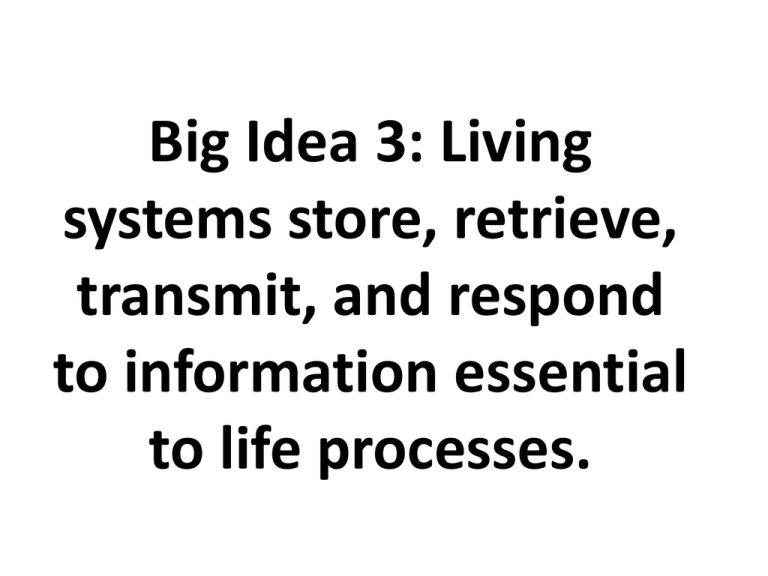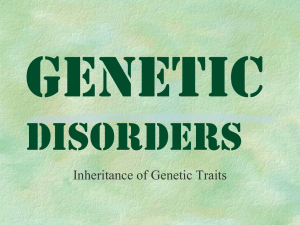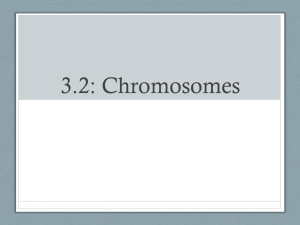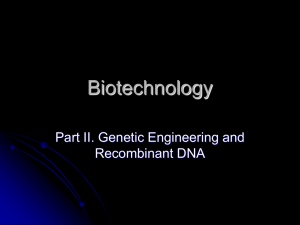
Big Idea 3: Living
systems store, retrieve,
transmit, and respond
to information essential
to life processes.
3.A: Heritable information
provides for continuity
of life.
3.A.1: DNA, and in some cases RNA,
is the primary source of heritable
information.
a. Genetic information is transmitted from one
generation to the next through DNA or RNA
-Genetic information is stored in and passed to
subsequent generations through DNA molecules
and, in some cases, RNA molecules.
-Noneukaryotic organisms have circular
chromosomes, while eukaryotic organisms have
multiple linear chromosomes, although there
are exceptions to this rule.
-Prokaryotes, viruses, and eukaryotes can
contain circular, double-stranded DNA plasmids.
-The proof that DNA is the carrier of genetic
information involved a number of important
historical experiments that you should know:
1. Watson, Crick, Wilkins and Franklin on the
structure of DNA.(double helix)
2. Avery-MacLeod-McCarthy experiment. (dead
mouse and S/R strain)
3. Hershey-Chase experiment. (radioactive P/S
with bacteriophage)
-DNA replication ensures continuity of
hereditary information
- Replication is semiconservative process.
– Replication requires DNA polymerase plus many
other essential cellular enzymes, occurs
bidirectionally and differs in the production of the
leading and lagging strands.
-Genetic information in retroviruses is a special
case and has alternative flow of information:
from RNA to DNA, made possible by reverse
transcriptase.
b. DNA and RNA molecules have structural
similarities and differences that define
function.
-Both have three components-sugar, phosphate,
and nitrogenous base- which form nucleotide
monomers that are connected by covalent
bonds to form a linear molecule with 3’ and 5’
ends, with the nitrogenous bases perpendicular
to the sugar-phosphate backbone.
-The basic structural differences include
i. DNA contains deoxyribose/RNA contains
ribose.
ii. RNA contains uracile in lieu of thymine in
DNA.
iii. DNA is usually double stranded, RNA is
usually single stranded.
iv. The two DNA strands in double stranded
DNA are antiparallel and held together by
hydrogen bonds.
-Both DNA and RNA exhibit specific nucleotide
base pairing that is conserved through
evolution: A pairs with T/U and C pairs with G.
-purines are single ringed (G & A)
-pyrimidines are single ringed (C & T/U)
-The sequence of RNA bases, together with the
structure of the RNA molecule determines the
RNA function
-mRNA carries information from the DNA to
the ribosome
-tRNA molecules bind specific amino acids
and allow information in the mRNA to be
translated to a linear polypeptide
sequence.
-rRNA molecules are functional building
blocks of ribosomes.
c. Genetic information flows form a sequence
of nucleotides in a gene to asequence of
amino acids in a protein.
-The enzyme RNA polymerase reads the DNA
molecule in the 3’ to 5’ direction and synthesizes
complementary mRNA molecules that
determine the order of amino acids in the
polypeptide
-In eukaryotic cells the mRNA transcript
undergoes a series of enzyme-regulated
modifications.
-excising introns
-adding poly-A tail to 3’ end
-adding GTP cap to 5’ end
-Translation of the mRNA occurs in the
cytoplasm on the ribosome
-In prokaryotic organisms, transcription is coupled
to translation of the message. Translation involves
energy and many steps, including initiation,
elongation, and temination
i. The mRNA interacts with the rRNA of the
ribosome to initiate translation at the start
codon.
ii. The sequence of nucleotides on the mRNA is
read in triplets called codons.
iii. Each codon encodes a specific amino acid,
and some amino acids have more than one
codon.
***No need to know the codon chart, just how
to use one if given it on the exam.
iv. tRNA brings the correct amino acid to the
correct place on the mRNA
v. The amino acid is transferred to the
growing peptide chain.
vi. The process continures along the mRNA
until a “stop” codon is reached.
vii. The process terminates by relase of the
newly synthesized polypeptide.
d. Phenotypes are determined through protein
activities.
-enzymatic reactions
-transport by proteins
-synthesis
-degredation
e. Genetic engineering tehniques can
manipulate the heritable information of DNA.
-gel electrophoresis
-plasmid based transformation
-restriction enzyme analysis of DNA
-polymerase chain reaction (PCR)
f. Illustrative examples of products of genetic
engineering include:
-genetically modified foods
-transgenic animals
-cloned animals
-pharmaceuticals, such as insulin
3.A.2: In eukaryotes, heritable
information is passed to the next
generation via processes that
include the cell cycle and mitosis or
meiosis plus fertilization.
a. The cell cycle is a complex set of stages that
is highly regulated with checkpoints, which
determine the ultimate fate of the cell.
-Interphase consists of three phases: G1, DNA
synthesis, G2
-The cell cycle is directed by internal controls or
checkpoints
-mitosis promoting factor (MPF)
-platelet derived growth factor (PDGF)
-cancer results from lack of cell cycle control
-Cyclins and cyclin-dependent kinases control
the cell cycle.
-Mitosis alternates with interphase in the cell
cycle.
-When a cell matures, it often enters a stage
(Go) where it no longer divides, but it can
reenter when given appropriate cues.
b. Mitosis passes a complete genome from the
parent cell to daughter cells.
-Mitosis occurs after DNA replication.
-Mitosis followed by cytokinesis produces two
genetically identical daughter cells.
-Mitosis plays a role in growht, repair, and
asexual reproduction.
-Mitosis is a continuous process with observable
structural features along the mitotic process.
c. Meiosis, a reduction division, followed by
fertilization ensures genetic diversity in
sexually reproducing organisms.
-Meiosis ensures that each gamete receives one
complete haploid (1n) set of chromosomes.
-During meiosis, homologous chromosomes are
paired, with one homologue originating from
the maternal parent, and the other from the
paternal parent.
-Separation of the homologous chromosomes
ensures that each gamete receives a haploid
(1n) set of chromosomes composed of both
maternal and paternal chromosomes.
-During meiosis, homologous chromatids
exchange genetic material via a process called
“crossing over”, which increases genetic
variation in the resulting gametes.
-Fertilization involves the fusion of two gametes,
increases genetic variation in populations, and
restores the diploid number of chromosomes.
3.A.3:The chromosomal basis of
inheritance provides an
understanding of the pattern of
passage (transmission) of genes
from parent to offspring.
a. Rules of probability can be applied to analyze
passage of single gene traits from parent to
offspring.
b. Segregation and independent assortment of
chromosomes result in genetic variation.
-Segregation and independent assortment can be
applied to genes that are on different
chromosomes.
-Genes that are adjacent and close to each other on
the same chromosome tend to move as a unit, the
probability that they will segregate as a unit is a
function of the distance between them.
-The pattern of inheritance (monohybrid,
dihybrid, sex-linked, and genes linked on the
same homologous chromosome) can often be
predicted from data that gives the parent
genotype/phenotype and/or the offspring
phenotypes/genotypes.
c. Certain human genetic disorders can be
attributed to the inheritance of single gene
traits or specific chromosomal changes such
as nondisjunction.
-sickle-cell anemia
-Tay-Sachs disease
-Huntington’s disease
-X-linked color blindness
-trisomy 21/Down’s Syndrome
-Klinefelter’s syndrome
d. Many ethical, social and medical issues
surround human genetic disorders
-Reproductive issues
-Civic issues such as ownership of genetic
information, privacy, historical contexts, etc.
3.A.4:The inheritance pattern of many
traits cannot be explained by simple
Mendelian genetics.
a. Many traits are the product of multiple genes
and/or physiological processes.
-Patterns of inheritance of many traits do not
follow ratios predicted by Mendel’s laws and can
be identified by quantitative analysis, where
observed phenotypic ratios statistically differ
from predicted ratios.
b. Some traits are determined by genes on sex
chromosomes.
-Sex-linked genes
-In mammals and flies, the Y chromosome is very
small and carries very few genes.
-In mammals and flies, females are XX and males
are XY; X linked recessive traits always expressed in
males.
-Some traits are sex limited, and expression
depends on the sex of the individual, such as milk
production in females and pattern baldness in
males.
c. Some traits resulf from nonnuclear
inheritance.
-Chloroplasts and mitochondria are randomly
assorted to gametes and daughter cells, thus
traits determined by chloroplasts and
mitochondrial DNA do not follow simple
Mendelian inheritance.
-In animals, mitochondrial DNA is transmitted by
the egg, not the sperm, and art thus maternally
inherited.
3.B: Expression of genetic information
involves cellular and molecular
mechanisms.
3.B.1: Gene regulation results in
differential gene expression,
leading to cell specialization.
a. Both DNA regulatory sequences,, regulatory
genes, and small regulatory RNAs are
involved in gene expression.
-Regulatory sequences are stretches of DNA that
interact with regulatory proteins to control
transcription
-Promoters
-Terminators
-Enhancers
b. Both positive and negative control
mechanisms regulate gene expression in
bacteria and viruses
-The expression of specific genes can be turned
on by the presence of an inducer.
-The expression of specific genes can be
inhibited by the presence of a repressor.
-Inducers and repressors are small molecules
that interact with the regulatory proteins and/or
regulatory sequences.
-Regulatory proteins inhibit gene expression by
binding to DNA and blocking transcription
(negative control).
-Regulatory proteins stimulate gene expression
by binding to DNA and stimulating transcription
(positive control) or binding to repressors to
inactivate repressor function.
-Certain genes are continuously expressed, they
are always turned on (ribosomal genes)
c. In eukaryotes, gene expression is complex and
control involves regulatory genes, regulatory
elements and transcription factors to act in
concert.
-Transcription factors bind to speciic DNA
sequences and/or other regulatory proteins.
-Some of these transcription factors are activators
(increase expression), while others are repressors
(decrease expression).
-The combination of transcription factors binding to
the regulatory regions at any one time determines
how much of the gene product will be produced.
d. Gene regulation accounts for some of the
phenotypic differences between organisms with
similar genes.
3.B.2: A variety of intercellular and
intracellular signal transmissions
mediate gene expression.
a. Signal transmission within and between cells
mediates gene expression.
-Cytokines regulate gene expression to allow for
cell replication and division.
-Mating pheromones in yeast trigger mating
gene expression.
-Levels of cAMP regulate metabolic gene
expression in bacteria.
-Expression fo the SRY gene triggers the male
sexual development pathway in animals.
-Ethylene levels cause changes in the production
of different enzymes allowing fruits to ripen.
-Seed germination and gibberellin.
b. Signal transmission within and between cells
mediates cell function.
-Mating pheromones in yeast triggers mating
genes expression and sexual reproduction.
-Morphogens stimulate cell differentiation and
development.
-Changes in p53 activity can result in cancer.
-HOX genes and their role in development.
3.C: The processing of genetic
information is imperfect and is a
source of genetic variation.
3.C.1: Changes in genotype can
result in changes in phenotype.
a. Alterations in a DNA sequence can lead to
changes in the type or amount of the protein
produced and the consequent phenotype.
-DNA mutations can be positive, negative, or
neutral based on the effect or the lack of effect
they have on the resulting nucleic acid or
protein and the phenotypes that are conferred
by the protein.
b. Erros in DNA replication or NA repair
mechanisms, and external factors, including
radiation and reactive chemicals, can cause
random changes, ex. Mutations in the DNA.
-Whether or not a mutation is detrimental,
beneficial or neutral depends on the
environmental context. Mutations are the
primary source of genetic variation.
c. Errors in mitosis or meiosis can result in
changes in phenotype
-Changes in chromosome number often result in
new phenotypes, including sterility caused by
triploidy and increased vigor of other polyploids
(plants).
-Changes in chromosome number often result in
human disorders with developmental
limitations, including Trisomy 21 (Down
syndrome) and XO (Turner syndrome).
d. Changes in genotype may affect phenotypes
that are subject to natural selection. Genetic
changes that enhance survival and
reproduction can be selected by
environmental conditions.
-Antibiotic resistance mutations
-Pesticide resistance mutations
-Sickle cell disorder and heterozygote
advantage.
-Selection results in evolutionary change.
3.C.2: Biological systems have
multiple processes that increase
genetic variation.
a. The imperfect nature of DNA rteplication and
repair increases variation.
b. The horizontal acquisitions of genetic
information primarily in prokaryotes via
transformation (uptake of naked DNA),
transduction (viral trnsmission of genetic
information), conjugation (Cell-to-cell
transfer via sex pillus) and transposition
(movement of DNA within and between DNA
molecules) increase variation.
c. Sexual reproduction in eukaryotes involving
gamete formation, including crossing-over
during meiosis and the random assortment of
chromosomes during meiosis, and fertilization
serve to increase variation. Reproduction
processes that increase genetic variation are
evolutionarily conserved and are shared by
various organisms
3.C.3: Viral replication results in
genetic variation, and viral infection
can introduce genetic variation into
the hosts.
a. Viral replication differs from other
reproductive strategies and generates genetic
variation via various mechanisms.
-Viruses have highly efficient replicative
capabilities that allow for rapid evolution and
acquisition of new phenotypes.
-Viruses replicate via a component assembly
model allowing one virus to produce many
progeny simultaneously via the lytic cycle.
-Virus replication allows for mutations to occur
through usual host pathways.
-RNA viruses lack replication error-checking
mechanisms, and thus have higher rates of
mutation.
-Related viruses can combine/recombine
information if they infect the same host cell.
-HIV is a well-studied system where the rapid
evolution of a virus within the host contributes
to the pathogenicity of viral infection.
b. The reproductive cycles of viruses facilitate
transfer of genetic information.
-Viruses transmit DNA or RNA when they infect
a host cell.
-transduction in bacteria
-transposons present in incoming DNA
-Some viruses are able to integrate into the host
DNA and establish latent (lysogenic) infections.
These latent viral genomes can result in new
properties for the host such as increased
pathogenicity in bacteria.
3.D: Cells communicate by
generating, transmitting and
receiving chemical signals.
3.D.1: Cell communication processes
share common natures thata reflect a
shared evolutionary history.
a. Communication involves transduction of
stimulatory or inhibitory signals from other
cells organisms or the environment.
b. Correct and appropriate signal transduction
processes are generally under strong
selective pressure.
c. In single-celled organisms, signal
transduction pathways influence how the cell
responds to its environment.
c. In single-celled organisms, signal
transduction pathways influence how the cell
responds to its environment.
-Use of chemical messengers by microbes to
communicate with other nearby cells and to
regulate specific pathways in response to
population density (quorum sensing).
-Use of pheromones to trigger reproduction and
developmental pathways.
-Response to external signals by bacteria that
influences cell movement.
d. In multicellular organisms, signal
transduction pathways coordinate the
activities within individual cells that support
the function of the organism as a whole.
-Epinephrine stimulation of glycogen breakdown
in mammals.
-Temperature determination of sex in some
vertebrate organisms (alligators and turtles).
-DNA repair mechanisms.
3.D.2: Cells communicate with each
other through direct contact with
other cells or from a distance via
chemical signaling.
a. Cells communicate by cell-to-cell contact.
-Immune cells interact by cell-cell contact,
antigen-presenting cells, helper T-cells and killer
T-cells.
-Plasmodesmata between plant cells allow
material to be transported from cell to cell.
b. Cells communicate over short distances by
using local regulators that target cells in the
vicinity of the emitting cells.
-Neurotransmitters
-Plant immune response
-Quorum sensing in bacteria
-Morphogens in embryonic development.
c. Signals released by one cell type can travel
long distances to target cells of another cell
type.
-Endocrine signals are produced by endocrine
cells that release signaling molecules, which are
specific and can travel long distances through
the blood to reach all parts of the body.
***MUST KNOW THE ENDOCRINE SYSTEM FOR
AP EXAM.***
Ex. Insulin, human growth hormone, thyroid
hormones, testosterone, estrogen
3.D.3: Signal transduction
pathways link signal reception with
cellular reponse.
a. Signaling beings with the recognition of a
chemical messenger, a ligand, by a receptor
protein.
-Different receptors recognize different chemical
messengers, which can be peptides, small chemicals
or proteins, in a specific one-to-one relationship.
-A receptor protein recognizes signal molecules,
causing the receptor protein’s shape to change,
which initiates transduction of the signal.
Ex. G-protein linked receptors, ligand-gated ion
channels, receptor tyrosine kinases.
b. Signal transduction is the process by which a
signal is converted to a cellular response.
-Signaling cascades relay signals from receptors
to cell targets, often amplifying the incoming
signals, with the result of appropriate responses
by the cell.
-Second messengers are often essential to the
function of the cascade.
Ex. Ligand-gated channels, second messengers
such as cyclic GMP and cyclic AMP calcium ions.
-Many signal transduction pathways include:
i. Protein modifications (an illustrative
example could be how methylation changes the
signaling process)
ii. Phosphorylation cascades in which a series
of protein kinases add a phosphate group to the
next protein in the cascade sequence.
3.D.4: Changes in the signal
transduction pathways an alter
cellular response.
a. Conditions where signal transductio is
blocked or defective can be deleterious,
preventative, or prophylactic.
-Diabetes, heart disease, neurological disease,
autoimmune disease, cancer, cholera
-Effects of neurotoxins, poisons, and pesticides.
-Drugs (Hypertensives, anesthetics,
antihistamines, birth control drugs)
3.E: Transmission of information
results in changes within and
between biological systems.
3.E.1: Individuals can act on
information and communicate it to
others.
a. Organisms exchange information with each
other in response to internal changes and
external cues, which can change behavior
-Fight or flight response
-Predator warnings
-Protection of young
-Plant-plant interactions due to herbivory
-Avoidance responses
b. Communication occurs through various
mechanisms.
-Living systems have a variety of signal behaviors
or cues that produce changes in the behavior of
other organisms and can result in differential
reproductive success.
Ex. Herbivory responses, teritorieal markings in
mammals, coloration in flowers
- Animals use visual, audible, tactile, electrical
and chemical signals to indicate dominance,
find food, establish territory, and ensure
reproductive success.
Ex. Bee dance, bird songs, territorial marking in
mammals, pack behavior in animals, herding or
flocking, predator warnings, colony and
swarming behavior in insects, coloration
c. Responses to information and
communication of information are vital to
natural selection and evolution
-Natural selection favors innate and learned
behaviors that increase survival and
reproduction.
Ex. Parent/offspring interaction, migration
patterns, courtship and mating behaviors,
foraging in bees, avoidance behavior to
electrical fences and traps
-Cooperative behavior tends to increase the
fitness of the individual and the survival of the
population.
Ex. Pack behavior, herd and flock behavior,
predator warning, colony and swarming in
insects.
3.E.2: Animals have nervous systems
that detect external and internal
signals, transmit and integrate
information and produce responses.
a. The neuron is the basic structure of the nervous
system that reflects function.
-A typical neuron has a cell body, axon, and
dendrites. Many axons have a myelin sheath that
acts as an electrical insulator.
-Te structure of a neuron allows for the detection,
generation, transmission and integration of signal
information.
-Schwann cells, which form the nyelin sheath, are
separated by gaps of unsheathed axon over which
the impulse travels as the signal propagates along
the neuron.
b. Communication occurs through various
mechanisms.
-Living systems have a variety of signal behaviors
or cues that produce changes in the behavior of
other organisms and can result in differential
reproductive success.
Ex. Herbivory responses, teritorieal markings in
mammals, coloration in flowers
- Animals use visual, audible, tactile, electrical
and chemical signals to indicate dominance,
find food, establish territory, and ensure
reproductive success.
Ex. Bee dance, bird songs, territorial marking in
mammals, pack behavior in animals, herding or
flocking, predator warnings, colony and
swarming behavior in insects, coloration
c. Responses to information and
communication of information are vital to
natural selection and evolution
-Natural selection favors innate and learned
behaviors that increase survival and
reproduction.
Ex. Parent/offspring interaction, migration
patterns, courtship and mating behaviors,
foraging in bees, avoidance behavior to
electrical fences and traps
-Cooperative behavior tends to increase the
fitness of the individual and the survival of the
population.
Ex. Pack behavior, herd and flock behavior,
predator warning, colony and swarming in
insects.









